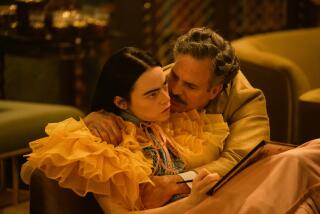‘Palm Beach Story’: That’s Rich
“Sullivan’s Travels” is director Preston Sturges’ acclaimed 1941 satire about a successful Hollywood director who decides to live the life of a hobo for a drama he intends to make. What he discovers, however, is what those facing the harsh realities of poverty and suffering really want is a good laugh.
That’s exactly what Sturges gave audiences in his next movie, “The Palm Beach Story,” which is about as far from the gritty world of the road, flophouses and chain gangs as imaginable.
Part of Chapman University’s Screwball Comedy Series, “The Palm Beach Story” is set in the upper-crust world of Park Avenue and Palm Beach.
According to early notes Sturges wrote for the screenplay, the off-the-wall 1942 comedy is based on the premise that “a pretty woman can do anything she wants and go anywhere she wants without money” and that “a pretty woman can use her appeal for the advancement of her husband.”
Joel McCrea (who played the idealistic director in “Sullivan’s Travels”) is Tom, a financially beleaguered young inventor, and Claudette Colbert is his sophisticated wife, Gerry, who is convinced Tom will do better without her. By leaving him, she’ll also find a man who can fulfill her need for wealth and luxury.
A group of raucous hunters--members of the Ale and Quail Club--buy the beautiful, and cashless, Gerry a train ticket to Palm Beach. On the trip south, she meets one of America’s wealthiest men, John D. Hackensacker III (Rudy Vallee). Infatuated, he buys her gowns and jewels and invites her to join him on his yacht for a trip to his Palm Beach mansion.
But Tom is not about to let his wife slip away, and he gets a little help from a millionaire friend: the “Wienie King” (Robert Dudley)--inventor of the Texas Wienie: “Lay off of ‘em! You’ll live longer”--who gives Tom the money to fly after Gerry.
Mary Astor plays Hackensacker’s much married sister, Maude, who immediately has designs on Tom, whom Gerry introduces as her brother. And so it goes.
“Palm Beach Story” wasn’t well received by critics at the time, according to James Curtis of Brea, author of “Between Flops: A Biography of Preston Sturges” (Harcourt, Brace and Co.; 1982).
“Sturges was kind of a critics’ darling up to that point,” said Curtis, noting the critical and box office success of “The Lady Eve,” “Sullivan’s Travels,” “The Great McGinty” and “Christmas in July.”
With “The Palm Beach Story,” he said, “it’s almost as if the critics were laying for him on this one. [New York Times critic] Bosley Crowther, who was a champion of Sturges’ work, dismissed ‘The Palm Beach Story’ as being talky and lethargic, devoid of action, as I recall. And Sturges at the time was really mystified by the backlash. He thought ‘The Palm Beach Story’ was as good as anything he had done, and I think time has proven him correct.”
* “The Palm Beach Story” screens at 7 tonight in Chapman University’s Argyros Forum, Room 208, 333 N. Glassell St., Orange. Not rated. Running time: 90 minutes. Free. (714) 997-6765.
*
“Hana-Bi” (“Fireworks”), the award-winning 1997 drama by director and Japanese TV star Takeshi Kitano, is this week’s offering from UC Irvine Film Society’s “Pleasures in the Dark” series.
Kitano plays Nishi, a police detective whose young daughter has died and whose wife is dying of cancer. When his partner is paralyzed in a shootout, Nishi’s violent tendencies are triggered: He quits the force, gets in trouble with a loan shark and tries to avenge a colleague’s death and his partner’s paralysis--all while he’s trying to make his wife’s final days as comfortable as possible. Translated separately, the words in the movie’s title mean “fire and flower.” The film won a Golden Lion at the Venice Film Festival, among other awards.
* “Hana-Bi” screens at 7 and 9 p.m. Friday in the Crystal Cove auditorium in the Student Center at UCI, near the corner of West Peltason and Pereira drives. In Japanese with English subtitles. Running time: 103 minutes. General admission: $4.50. (949) 824-5588.
*
Chapman University’s African Film Series continues with “The Blue Eyes of Yonta,” a 1991 film by second-generation filmmaker Flora Gomez. The film, the first to come out of Portuguese-speaking Guinea-Bisao, shows the experience of a beautiful woman, Yonta, who is living with a legacy of the anti-colonial struggle but knows nothing about it. The film examines members of the older generation and their ideas about how youth should behave.
* “The Blue Eyes of Yonta” screens at 8 p.m. Tuesday in Chapman University’s Argyros Forum, room 209, 333 N. Glassell St., Orange. In Portuguese with English subtitles. Running time: 90 minutes. Free. (949) 997-6765.
More to Read
Only good movies
Get the Indie Focus newsletter, Mark Olsen's weekly guide to the world of cinema.
You may occasionally receive promotional content from the Los Angeles Times.










